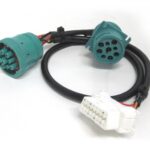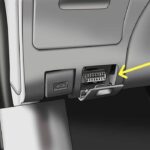The 2004 Jeep Liberty, a popular SUV known for its off-road capability and rugged design, utilizes an On-Board Diagnostics system, specifically OBD2, to monitor its various systems. When something goes wrong, the check engine light illuminates, and the system stores diagnostic trouble codes (DTCs). Understanding these 2004 Jeep Liberty Obd2 Codes is the first step in diagnosing and resolving issues, potentially saving you time and money on repairs. This guide will help you understand how to retrieve and interpret these codes for your 2004 Jeep Liberty.
Understanding OBD2 Codes for Your 2004 Jeep Liberty
OBD2 (On-Board Diagnostics II) is a standardized system implemented in vehicles sold in the United States from 1996 onwards. It’s designed to provide vehicle owners and technicians with access to the health information of various vehicle subsystems. For a 2004 Jeep Liberty, the OBD2 system is crucial for identifying problems related to the engine, transmission, emissions control, and other systems.
When a sensor detects a reading outside of the normal parameters, the vehicle’s computer, also known as the Powertrain Control Module (PCM) or Engine Control Unit (ECU), registers a DTC and often turns on the check engine light. These 2004 Jeep Liberty OBD2 codes are alphanumeric codes that correspond to specific problems.
It’s important to note that while these codes provide a starting point for diagnosis, they don’t pinpoint the exact failed component. Further investigation and testing are usually required to accurately identify the root cause of the problem.
How to Retrieve OBD2 Codes on a 2004 Jeep Liberty (The “Key Trick”)
While a dedicated OBD2 scanner provides the most convenient and detailed way to read 2004 Jeep Liberty OBD2 codes, there’s a built-in method, often referred to as the “key trick,” that can display basic codes on the odometer. This method can be helpful for a quick initial diagnosis without needing any special tools.
Here’s how to use the “key trick” on your 2004 Jeep Liberty:
- Ensure the ignition is off.
- Insert the key into the ignition.
- Push and hold down the odometer reset button.
- While holding the button, turn the ignition key to the RUN position (do not start the engine).
- Release the odometer reset button.
The odometer will then cycle through a series of displays, starting with numbers like “111111” to “999999,” followed by the vehicle’s serial number. After this sequence, if there are any stored 2004 Jeep Liberty OBD2 codes, they will be displayed on the odometer, often starting with the letter “P” (for Powertrain codes). If no codes are present, it will typically display “done” or “—“.
If this method doesn’t work, you might consider trying the older OBDI “key trick” method as outlined in some resources, though it’s less likely to be applicable for a 2004 model. However, for reliable and comprehensive 2004 Jeep Liberty OBD2 codes retrieval, using an OBD2 scanner is highly recommended. Scanners are readily available and offer more detailed information than the basic “key trick.”
Common 2004 Jeep Liberty OBD2 Codes and Meanings
Understanding the meaning of 2004 Jeep Liberty OBD2 codes is crucial for effective troubleshooting. OBD2 codes are generally structured with a letter followed by four digits. The letter indicates the system:
- P – Powertrain (Engine and Transmission)
- C – Chassis (Braking, Suspension, Steering)
- B – Body (Body control modules, Interior)
- U – Network (Communication systems)
The first digit after the letter specifies whether the code is generic (standardized across manufacturers) or manufacturer-specific. For powertrain codes (P):
- P0xxx: Generic OBD2 code
- P1xxx, P2xxx, P3xxx: Manufacturer-specific codes
Here are some common 2004 Jeep Liberty OBD2 codes and their general meanings, categorized for easier understanding. This is not an exhaustive list, but it covers many potential issues you might encounter.
Engine Related Codes (Powertrain – P0xxx)
-
P0107/P0108 – MAP Sensor Voltage Low/High: Indicates a problem with the Manifold Absolute Pressure (MAP) sensor circuit. This sensor measures air pressure in the intake manifold, crucial for fuel delivery and engine performance. A faulty MAP sensor can lead to poor fuel economy, rough idling, and stalling.
Alt Text: A Manifold Absolute Pressure (MAP) sensor, a common component in the 2004 Jeep Liberty engine management system, responsible for measuring intake manifold pressure.
-
P0112/P0113 – Intake Air Temperature Sensor Voltage Low/High: Signifies issues with the Intake Air Temperature (IAT) sensor circuit. This sensor measures the temperature of the air entering the engine. Incorrect readings can affect air-fuel mixture calculations, leading to performance and fuel efficiency problems.
-
P0117/P0118 – Engine Coolant Temperature Sensor Voltage Low/High: Points to problems with the Engine Coolant Temperature (ECT) sensor circuit. The ECT sensor monitors engine coolant temperature, essential for engine temperature regulation and fuel management. Faulty readings can cause overheating, poor cold starts, and incorrect fan operation.
-
P0122/P0123 – Throttle Position Sensor Voltage Low/High: Indicates a problem with the Throttle Position Sensor (TPS) circuit. The TPS monitors the throttle valve’s position, which is critical for determining engine load and driver demand. Issues with the TPS can result in erratic idling, hesitation, and transmission shifting problems.
-
P0131 – P0167 – O2 Sensor Circuit Low/High Voltage, Slow Response (Bank 1 & Bank 2, Sensor 1 & Sensor 2/3): These codes relate to the Oxygen (O2) sensors. O2 sensors monitor the oxygen content in the exhaust gas to ensure the air-fuel mixture is optimal for emissions and engine efficiency. Problems with O2 sensors can cause poor fuel economy, failed emissions tests, and catalytic converter damage. The 2004 Jeep Liberty typically has multiple O2 sensors (Bank 1 Sensor 1, Bank 1 Sensor 2, and potentially Bank 2 Sensors depending on engine configuration).
Alt Text: An oxygen sensor, a critical component in the 2004 Jeep Liberty’s emission control system, responsible for monitoring exhaust gas oxygen levels.
-
P0300 – P0308 – Misfire Detected (Multiple Cylinders/Cylinder Specific): These codes indicate engine misfires. A misfire occurs when one or more cylinders are not firing correctly, leading to rough running, reduced power, and potential engine damage. Misfires can be caused by various issues, including faulty spark plugs, ignition coils, fuel injectors, vacuum leaks, or compression problems.
-
P0401 – Insufficient EGR Flow: Points to problems with the Exhaust Gas Recirculation (EGR) system. The EGR system recirculates a portion of exhaust gas back into the intake manifold to reduce NOx emissions. Insufficient flow can be due to a clogged EGR valve, vacuum leaks, or sensor issues.
-
P0441/P0442/P0455/P0456 – Evaporative Emission Control System (EVAP) Incorrect Purge Flow/Small Leak/Large Leak/Very Small Leak: These codes indicate problems within the EVAP system, which prevents fuel vapors from escaping into the atmosphere. Leaks in the EVAP system are common and can be caused by a loose or faulty gas cap, damaged hoses, or malfunctioning components like the purge valve or vent valve.
Alt Text: A simplified diagram of an EVAP (Evaporative Emission Control System), highlighting components relevant to diagnosing EVAP system leaks in a 2004 Jeep Liberty.
Transmission Related Codes (Powertrain – P07xx)
-
P0700 – Transmission Control System Malfunction: This is a generic code indicating a problem within the transmission control system. It often accompanies other transmission-specific codes that provide more detail.
-
P0740 – Torque Converter Clutch Circuit Malfunction: Indicates a problem with the Torque Converter Clutch (TCC) circuit. The TCC is responsible for locking the torque converter at higher speeds to improve fuel efficiency. Issues with the TCC can lead to reduced fuel economy and transmission performance problems.
-
P0751/P0756 – Shift Solenoid A/B Performance or Stuck Off: These codes indicate problems with shift solenoids within the automatic transmission. Shift solenoids control the flow of transmission fluid to engage different gears. Malfunctioning solenoids can cause shifting problems, such as harsh shifts, slipping, or failure to shift.
Other Potential Codes
The original list also contains codes beyond the P0xxx range, including some OBD1 codes and codes that might be more generic Chrysler/Jeep codes. While less likely to be directly retrieved via the OBD2 “key trick” or a basic scanner focused on engine and emissions, these codes might appear with more advanced diagnostic tools. It’s always best to use a proper OBD2 scanner to get the most accurate and relevant codes for your 2004 Jeep Liberty.
Troubleshooting and Repair Tips for 2004 Jeep Liberty OBD2 Codes
Once you have retrieved the 2004 Jeep Liberty OBD2 codes, you should:
- Record the Codes: Write down all the codes displayed. This will be helpful for further diagnosis and reference.
- Research the Codes: Use online resources, repair manuals, or OBD2 code databases to understand the specific meaning of each code and potential causes.
- Visual Inspection: Check for any obvious issues, such as loose gas cap, disconnected vacuum lines, damaged wiring, or fluid leaks.
- Use an OBD2 Scanner for More Information: A scanner can provide freeze frame data (engine conditions when the code was set) and allow you to clear codes after repairs.
- Address Codes Systematically: Start with the most critical or frequently occurring codes. Sometimes, fixing one issue can resolve multiple codes.
- Consult a Professional: If you are unsure about diagnosis or repair, or if the problem is complex, it’s always best to consult a qualified mechanic. Especially for transmission or internal engine issues, professional expertise is recommended.
Disclaimer: This guide is intended for informational purposes only and should not be considered a substitute for professional automotive diagnosis and repair. The provided OBD2 code descriptions are general and may not be specific to all situations. Always consult a repair manual and qualified technician for accurate diagnosis and repair procedures for your 2004 Jeep Liberty.
Understanding 2004 Jeep Liberty OBD2 codes empowers you to take a proactive approach to vehicle maintenance and repair. By utilizing the “key trick” or an OBD2 scanner and understanding the meaning of the codes, you can effectively communicate with mechanics or perform DIY repairs, keeping your Jeep Liberty running smoothly.

